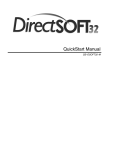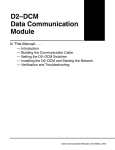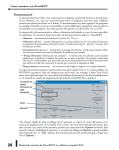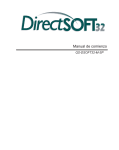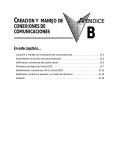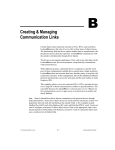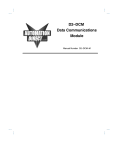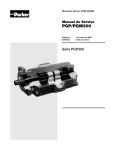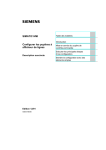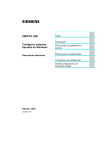Download QuickStart Manual
Transcript
QuickStart Manual QS--DSOFT32--M WARNING Thank you for purchasing automation equipment from Automationdirect.com. We want your new automation equipment to operate safely. Anyone who installs or uses this equipment should read this publication (and any other relevant publications) before installing or operating the equipment. To minimize the risk of potential safety problems, you should follow all applicable local and national codes that regulate the installation and operation of your equipment. These codes vary from area to area and usually change with time. It is your responsibility to determine which codes should be followed, and to verify that the equipment, installation, and operation is in compliance with the latest revision of these codes. At a minimum, you should follow all applicable sections of the National Fire Code, National Electrical Code, and the codes of the National Electrical Manufacturer’s Association (NEMA). There may be local regulatory or government offices that can also help determine which codes and standards are necessary for safe installation and operation. Equipment damage or serious injury to personnel can result from the failure to follow all applicable codes and standards. We do not guarantee the products described in this publication are suitable for your particular application, nor do we assume any responsibility for your product design, installation, or operation. If you have any questions concerning the installation or operation of this equipment, or if you need additional information, please call us at 1--770--844--4200. This publication is based on information that was available at the time it was printed. At Automationdirect.com we constantly strive to improve our products and services, so we reserve the right to make changes to the products and/or publications at any time without notice and without any obligation. This publication may also discuss features that may not be available in certain revisions of the product. Trademarks This publication may contain references to products produced and/or offered by other companies. The product and company names may be trademarked and are the sole property of their respective owners. Automationdirect.com disclaims any proprietary interest in the marks and names of others. Stage is a trademark of Koyo Electronics Industries Co., LTD. Texas Instruments is a registered trademark of Texas Instruments, Inc. TI, TIWAY, Series 305, Series 405, TI305, and TI405 are trademarks of Texas Instruments, Inc. Siemens and SIMATIC are registered trademarks of Siemens, AG. GE is a registered trademark of General Electric Corporation. Series One is a registered trademark of GE Fanuc Automation North America, Inc. MODBUS is a registered trademark of Gould, Inc. IBM is a registered trademark of International Business Machines. MS-DOS and Microsoft are registered trademarks of Microsoft Corporation. Windows is a trademark of Microsoft Corporation. OPTOMUX and PAMUX are trademarks of OPTO 22. Copyright 1999, Automationdirect.com Incorporated All Rights Reserved No part of this manual shall be copied, reproduced, or transmitted in any way without the prior, written consent of Automationdirect.com Incorporated. Automationdirect.com retains the exclusive rights to all information included in this document. 1 Manual Revisions If you contact us in reference to this manual, remember to include the revision number. Title: DirectSOFT Quick Start User Manual Manual Number: QS--DSOFT32--M Issue Date Effective Pages Description of Changes Original 9/96 Cover/Copyright Contents Manual Revisions 1 — 57 Original Issue 2nd Edition 2/97 Contents Manual Revisions 1 — 56 Down size format 3rd Edition 6/98 Contents Manual Revisions 1 — 56 Add D3--350 Release 2.3 (3 diskettes) 4th Edition 8/99 Contents Manual Revisions 1 — 56 Release 3.0, 32--bit application (CD) 1 Table of Contents i Introduction . . . . . . . . . . . . . . . . . . . . . . . . . . . . . . . . . . . . . . . . . . . . . . . . . . . . . . . . . . . . . . . . . . . . . . . . . The Purpose of this Supplementary Manual . . . . . . . . . . . . . . . . . . . . . . . . . . . . . . . . . . . . . . . . . . . Who Can and Should Use DirectSOFT? . . . . . . . . . . . . . . . . . . . . . . . . . . . . . . . . . . . . . . . . . . . . . . 1 1 1 Preparing for Installation . . . . . . . . . . . . . . . . . . . . . . . . . . . . . . . . . . . . . . . . . . . . . . . . . . . . . . . . . . . . . Getting to Know Windows . . . . . . . . . . . . . . . . . . . . . . . . . . . . . . . . . . . . . . . . . . . . . . . . . . . . . . . . . . Check Your PC Hardware Requirements . . . . . . . . . . . . . . . . . . . . . . . . . . . . . . . . . . . . . . . . . . . . . Power Supply . . . . . . . . . . . . . . . . . . . . . . . . . . . . . . . . . . . . . . . . . . . . . . . . . . . . . . . . . . . . . . . . . . . . . DirectSOFT32 package contents . . . . . . . . . . . . . . . . . . . . . . . . . . . . . . . . . . . . . . . . . . . . . . . . . . . . 2 2 2 2 2 PLC Compatibility . . . . . . . . . . . . . . . . . . . . . . . . . . . . . . . . . . . . . . . . . . . . . . . . . . . . . . . . . . . . . . . . . . . Supported Devices . . . . . . . . . . . . . . . . . . . . . . . . . . . . . . . . . . . . . . . . . . . . . . . . . . . . . . . . . . . . . . . . 3 3 Installation of DirectSOFT32 Software . . . . . . . . . . . . . . . . . . . . . . . . . . . . . . . . . . . . . . . . . . . . . . . . Step 1: Load the CD . . . . . . . . . . . . . . . . . . . . . . . . . . . . . . . . . . . . . . . . . . . . . . . . . . . . . . . . . . . . . . . Step 2: Review your options . . . . . . . . . . . . . . . . . . . . . . . . . . . . . . . . . . . . . . . . . . . . . . . . . . . . . . . . Step 3: Enter the Security Code . . . . . . . . . . . . . . . . . . . . . . . . . . . . . . . . . . . . . . . . . . . . . . . . . . . . . Step 4: Unpacking the software . . . . . . . . . . . . . . . . . . . . . . . . . . . . . . . . . . . . . . . . . . . . . . . . . . . . . Step 5: End Other Windows Tasks . . . . . . . . . . . . . . . . . . . . . . . . . . . . . . . . . . . . . . . . . . . . . . . . . . . Step 6: DirectSOFT32 License Agreement . . . . . . . . . . . . . . . . . . . . . . . . . . . . . . . . . . . . . . . . . . . Step 7: Enter Your Name and Company . . . . . . . . . . . . . . . . . . . . . . . . . . . . . . . . . . . . . . . . . . . . . Step 8: Select Installation Directory . . . . . . . . . . . . . . . . . . . . . . . . . . . . . . . . . . . . . . . . . . . . . . . . . . Step 9: Select Installation Type . . . . . . . . . . . . . . . . . . . . . . . . . . . . . . . . . . . . . . . . . . . . . . . . . . . . . . Step 10: Custom Installation . . . . . . . . . . . . . . . . . . . . . . . . . . . . . . . . . . . . . . . . . . . . . . . . . . . . . . . . Step 11: Program Installation . . . . . . . . . . . . . . . . . . . . . . . . . . . . . . . . . . . . . . . . . . . . . . . . . . . . . . . Step 12: Program Verification . . . . . . . . . . . . . . . . . . . . . . . . . . . . . . . . . . . . . . . . . . . . . . . . . . . . . . . 4 4 4 4 4 5 5 5 6 6 6 7 7 Building an Example Program . . . . . . . . . . . . . . . . . . . . . . . . . . . . . . . . . . . . . . . . . . . . . . . . . . . . . . . . What You Will Learn . . . . . . . . . . . . . . . . . . . . . . . . . . . . . . . . . . . . . . . . . . . . . . . . . . . . . . . . . . . . . . . Example . . . . . . . . . . . . . . . . . . . . . . . . . . . . . . . . . . . . . . . . . . . . . . . . . . . . . . . . . . . . . . . . . . . . . . . . . Ladder Logic Example . . . . . . . . . . . . . . . . . . . . . . . . . . . . . . . . . . . . . . . . . . . . . . . . . . . . . . . . . . . . . Step 1: Enter the Programming Mode . . . . . . . . . . . . . . . . . . . . . . . . . . . . . . . . . . . . . . . . . . . . . . . . Step 2: Start a New Project . . . . . . . . . . . . . . . . . . . . . . . . . . . . . . . . . . . . . . . . . . . . . . . . . . . . . . . . . Step 3: Switch to the Edit Mode . . . . . . . . . . . . . . . . . . . . . . . . . . . . . . . . . . . . . . . . . . . . . . . . . . . . . Step 4: Using the Ladder Palette to Enter the First Element . . . . . . . . . . . . . . . . . . . . . . . . . . . . . Step 5: Using the SP0 Relay in Our Program. . . . . . . . . . . . . . . . . . . . . . . . . . . . . . . . . . . . . . . . . . Step 6: Using the Box Browser . . . . . . . . . . . . . . . . . . . . . . . . . . . . . . . . . . . . . . . . . . . . . . . . . . . . . . Step 7: Scrolling the Box Class Window . . . . . . . . . . . . . . . . . . . . . . . . . . . . . . . . . . . . . . . . . . . . . . Step 8: Entering a Preset in the Accumulator . . . . . . . . . . . . . . . . . . . . . . . . . . . . . . . . . . . . . . . . . Step 9: Connecting Elements in Parallel . . . . . . . . . . . . . . . . . . . . . . . . . . . . . . . . . . . . . . . . . . . . . . Step 10: Inserting an Output Box . . . . . . . . . . . . . . . . . . . . . . . . . . . . . . . . . . . . . . . . . . . . . . . . . . . . Step 11: Entering the Address to Hold the Preset . . . . . . . . . . . . . . . . . . . . . . . . . . . . . . . . . . . . . . Step 12: Enabling the Documentation Options . . . . . . . . . . . . . . . . . . . . . . . . . . . . . . . . . . . . . . . . Step 13: Entering a Comment . . . . . . . . . . . . . . . . . . . . . . . . . . . . . . . . . . . . . . . . . . . . . . . . . . . . . . . Step 14: Assigning a Nickname to the Preset Output . . . . . . . . . . . . . . . . . . . . . . . . . . . . . . . . . . . Step 15: Adding an Internal Relay to Start the Timer . . . . . . . . . . . . . . . . . . . . . . . . . . . . . . . . . . . Step 16: Assigning a Nickname to the Start Contact . . . . . . . . . . . . . . . . . . . . . . . . . . . . . . . . . . . Step 17: Adding a Normally Closed Contact . . . . . . . . . . . . . . . . . . . . . . . . . . . . . . . . . . . . . . . . . . Step 18: Adding a Nickname to the Normally Closed Contact . . . . . . . . . . . . . . . . . . . . . . . . . . . Step 19: Inserting the Timer Instruction . . . . . . . . . . . . . . . . . . . . . . . . . . . . . . . . . . . . . . . . . . . . . . . Step 20: Adding the Counter . . . . . . . . . . . . . . . . . . . . . . . . . . . . . . . . . . . . . . . . . . . . . . . . . . . . . . . . Step 21: Entering the Counter Data . . . . . . . . . . . . . . . . . . . . . . . . . . . . . . . . . . . . . . . . . . . . . . . . . . Step 22: Assigning a Nickname to the Counter . . . . . . . . . . . . . . . . . . . . . . . . . . . . . . . . . . . . . . . . Step 23: Making the Counter Self-Resetting . . . . . . . . . . . . . . . . . . . . . . . . . . . . . . . . . . . . . . . . . . 8 8 8 8 9 9 10 11 12 13 13 14 15 15 16 17 17 19 21 22 23 23 24 26 27 27 28 ii Table of Contents Step 24: Adding a Contact for Resetting on the First Scan . . . . . . . . . . . . . . . . . . . . . . . . . . . . . . Step 25: Documenting the Function of the Counter . . . . . . . . . . . . . . . . . . . . . . . . . . . . . . . . . . . . Step 26: Adding a Comparative Boolean Instruction . . . . . . . . . . . . . . . . . . . . . . . . . . . . . . . . . . . . Step 27: Adding a Conditional Output . . . . . . . . . . . . . . . . . . . . . . . . . . . . . . . . . . . . . . . . . . . . . . . . Step 28: Copying to the Clipboard . . . . . . . . . . . . . . . . . . . . . . . . . . . . . . . . . . . . . . . . . . . . . . . . . . . Step 29: Pasting to your Program . . . . . . . . . . . . . . . . . . . . . . . . . . . . . . . . . . . . . . . . . . . . . . . . . . . Step 30: Ending the Program . . . . . . . . . . . . . . . . . . . . . . . . . . . . . . . . . . . . . . . . . . . . . . . . . . . . . . . 30 32 33 33 35 36 38 Connecting Online to a PLC & Downloading the Program . . . . . . . . . . . . . . . . . . . . . . . . . . . . . . Create a Standard Serial Link . . . . . . . . . . . . . . . . . . . . . . . . . . . . . . . . . . . . . . . . . . . . . . . . . . . . . . . Link Status . . . . . . . . . . . . . . . . . . . . . . . . . . . . . . . . . . . . . . . . . . . . . . . . . . . . . . . . . . . . . . . . . . . . . . . Writing your Program to the PLC . . . . . . . . . . . . . . . . . . . . . . . . . . . . . . . . . . . . . . . . . . . . . . . . . . . . 39 39 42 43 Monitoring the Program with a Data View . . . . . . . . . . . . . . . . . . . . . . . . . . . . . . . . . . . . . . . . . . . . . Creating a Data View . . . . . . . . . . . . . . . . . . . . . . . . . . . . . . . . . . . . . . . . . . . . . . . . . . . . . . . . . . . . . . Adding Dynamic ON/OFF Edit Buttons . . . . . . . . . . . . . . . . . . . . . . . . . . . . . . . . . . . . . . . . . . . . . . . Entering the Run Mode . . . . . . . . . . . . . . . . . . . . . . . . . . . . . . . . . . . . . . . . . . . . . . . . . . . . . . . . . . . . Observing the Status of Elements . . . . . . . . . . . . . . . . . . . . . . . . . . . . . . . . . . . . . . . . . . . . . . . . . . . Using the Edit Buttons to Change Status . . . . . . . . . . . . . . . . . . . . . . . . . . . . . . . . . . . . . . . . . . . . . Writing Edits to the PLC . . . . . . . . . . . . . . . . . . . . . . . . . . . . . . . . . . . . . . . . . . . . . . . . . . . . . . . . . . . . 44 44 45 46 47 47 48 Special Data View Instructions for DL305 Family . . . . . . . . . . . . . . . . . . . . . . . . . . . . . . . . . . . . . . . DirectNET Restrictions . . . . . . . . . . . . . . . . . . . . . . . . . . . . . . . . . . . . . . . . . . . . . . . . . . . . . . . . . . . . . Changing the Value to Binary to Observe All 8 Bits. . . . . . . . . . . . . . . . . . . . . . . . . . . . . . . . . . . . . Changing to the Run Mode . . . . . . . . . . . . . . . . . . . . . . . . . . . . . . . . . . . . . . . . . . . . . . . . . . . . . . . . . Enabling the All Status ON . . . . . . . . . . . . . . . . . . . . . . . . . . . . . . . . . . . . . . . . . . . . . . . . . . . . . . . . . Entering Data for the Status Register . . . . . . . . . . . . . . . . . . . . . . . . . . . . . . . . . . . . . . . . . . . . . . . . Writing the Edits to the PLC . . . . . . . . . . . . . . . . . . . . . . . . . . . . . . . . . . . . . . . . . . . . . . . . . . . . . . . . 49 49 50 51 51 51 52 Troubleshooting Guide . . . . . . . . . . . . . . . . . . . . . . . . . . . . . . . . . . . . . . . . . . . . . . . . . . . . . . . . . . . . . . Communication Problems . . . . . . . . . . . . . . . . . . . . . . . . . . . . . . . . . . . . . . . . . . . . . . . . . . . . . . . . . . Comm Error Connecting to PLC . . . . . . . . . . . . . . . . . . . . . . . . . . . . . . . . . . . . . . . . . . . . . . . . . . . . . Internal Modem Card Conflicts . . . . . . . . . . . . . . . . . . . . . . . . . . . . . . . . . . . . . . . . . . . . . . . . . . . . . . Mouse Driver Conflicts . . . . . . . . . . . . . . . . . . . . . . . . . . . . . . . . . . . . . . . . . . . . . . . . . . . . . . . . . . . . . Swapping Ports to Solve a Mouse Conflict . . . . . . . . . . . . . . . . . . . . . . . . . . . . . . . . . . . . . . . . . . . . Other Driver Conflicts . . . . . . . . . . . . . . . . . . . . . . . . . . . . . . . . . . . . . . . . . . . . . . . . . . . . . . . . . . . . . . Driver Conflicts with Laptop Computers . . . . . . . . . . . . . . . . . . . . . . . . . . . . . . . . . . . . . . . . . . . . . . Power Management Conflicts . . . . . . . . . . . . . . . . . . . . . . . . . . . . . . . . . . . . . . . . . . . . . . . . . . . . . . . Specialized Video Device Driver Problems . . . . . . . . . . . . . . . . . . . . . . . . . . . . . . . . . . . . . . . . . . . . Conflicts with other PLC Vendor Software Drivers . . . . . . . . . . . . . . . . . . . . . . . . . . . . . . . . . . . . . Non--Shunted Power Supplies . . . . . . . . . . . . . . . . . . . . . . . . . . . . . . . . . . . . . . . . . . . . . . . . . . . . . . Screen Saver Conflicts . . . . . . . . . . . . . . . . . . . . . . . . . . . . . . . . . . . . . . . . . . . . . . . . . . . . . . . . . . . . . Printing Problems . . . . . . . . . . . . . . . . . . . . . . . . . . . . . . . . . . . . . . . . . . . . . . . . . . . . . . . . . . . . . . . . . Programming Cables . . . . . . . . . . . . . . . . . . . . . . . . . . . . . . . . . . . . . . . . . . . . . . . . . . . . . . . . . . . . . . 53 53 54 54 54 55 55 55 56 56 56 56 56 57 57 11 Introduction Introduction The Purpose of With this Quick Start manual, you should learn enough of the basics to get started this Supplementary without having to read the Users manual that covers all of the details of DirectSOFT32. If you have received this with your DirectSOFT demo disk, it will Manual provide you with a sampling of how easy DirectSOFT32 is to use. For those who have purchased the full version of DirectSOFT32, exercise caution: This is not intended to replace reading the Users Manual. This is intended only as a supplement. This is only a quick start! Who Can and If you have a PLC belonging to the DirectLOGIC CPU family, you can use DirectSOFT to create your ladder logic programs. The families of PLCs (DL05, Should Use DL105, DL205, DL305 and DL405) that currently exist under this description are DirectSOFT? shown below. We have included some other useful and related information. DirectSOFT32 has added the following functionality; D set up a DV1000 Data Access Unit D tune PID loops for the D2--250, D3--350, and D4--450 D set up the parameters for Drum Sequencers in the DL05, DL105, D2--250, D3--350, and D4--450 DirectSOFT will also work with many DirectLOGIC compatible products (not shown in the diagram). If you fall into this category, however, the chart on the next page shows you a complete list of which products work with the software. Diagram Showing the Basic System Your computer Compatibility with DirectSOFT installed DL340 CPU DL405 CPUs Two or three built-in ports Max. baud= 19.2K DL405 & DCM Two built-in ports Requires RS232/422 converter if multi-drop Max. baud = 38.4K DL450 DV-1000 Data Access Unit Can be used with any PLC belonging to the DL05, DL105, DL205 or DL405 families. Using DirectSOFT greatly simplifies setup. Setup for Drum Sequencer and Excellent choice if bottom PID Loops port on DL405 is already Allows higher being used performance with Allows higher rates up to 38.4K performance with rates baud up to 38.4K baud DL205 CPUs Built-in ports. Requires RS232/422 converter if multi-drop Max. baud= 38.4K DL305 & DCU Use an RS422 DCU if multi-drop and a third port is required. Maximum baud rate= 19.2K DL05 Two Built-in Ports Max. baud= 9.6K Setup for Drum Sequencer DL105 One Built-in Port Max. baud= 9.6K Setup for Drum Sequencer 2 Installation Preparing for Installation Getting to Know Windows DirectSOFT32 software runs under 32--bit Windows operating systems (95/98/NT). If you are more accustomed to using Windows 3.1, please take a moment to study your PC’s reference manual on the operation of Windows 95/98/NT. Check Your PC Hardware Requirements Please check the following requirements when choosing your PC configuration. System Requirements D D D D D Windows 95/98/NT-compatible Pentium 133 (or higher) 32Mb RAM 11Mb available hard drive disk space CD-ROM drive Color monitor, (640x480 or greater) NOTE on Laptops: DirectSOFT32 is perfectly suitable for use with laptop computers as long as they meet the requirements shown above. However, there can be a few problem areas. One inconvenient problem is when your laptop only has one COM port and does not have a built-in mouse. In this case, you will have to use the COM port for the PLC communications instead of the mouse connection. Tip on Monitors: Any size monitor will work, but larger monitors enhance the display capabilities of DirectSOFT32. Also, we strongly recommend a color monitor. DirectSOFT32 makes use of color to note certain conditions, such as program editing changes, error conditions, etc. It will work with monochrome monitors, but the results are enhanced with color monitors. Power Supply DirectSOFT32 package contents It is highly recommended that the computer DirectSOFT32 operates on has some form of power surge protection. A quality surge protector will protect your computer from most surges and spikes however, an uninterruptible power supply (UPS) will provide the ultimate protection. A UPS provides complete isolation between the AC power source and the computer and has battery backup for blackout and brownout conditions. Now is the time to review the contents of your DirectSOFT32 software package. You should have the following items: D D D D D D D CD ROM Quick Start Manual Learning Guide Manual License Agreement Registration Card Thank You Letter Feedback Form Installation PLC Compatibility DirectSOFT Programming DirectSOFT Programming DirectSOFT Site Licenses DirectSOFT OEM License DirectSOFT DDE Server Family CPU PC--PGMSW Single Family DL05 (requires Rel. 2.4 or later) 3 PC--PGM105 3 3 DL105 F1--130** (requires Rel. 2.0 or later) 3 PC--PGM105 3 3 DL205 D2--230 3 PC--PGM205 3 PC--D2OEM 3 D2--240 3 PC--PGM205 3 PC--D2OEM 3 D2--250 (requires Rel. 2.1 or later) 3 PC--PGM205 3 PC--D2OEM 3 D3--330*, D3--330P* 3 3 PC--D3OEM 3 D3--340 3 3 PC--D3OEM 3 D3--350 (requires Rel.2.3 or later) 3 3 PC--D3OEM 3 D4--430 3 3 PC--D4OEM 3 D4--440** 3 3 PC--D4OEM 3 D4--450** (requires Rel 2.0 or later) 3 3 PC--D4OEM 3 IC610CPU105* 3 3 PC--D3OEM 3 IC610CPU106* 3 3 PC--D3OEM 3 325--07*, PPX:325--07* 3 3 PC--D3OEM 3 330--37*, PPX:330--37* 3 3 PC--D3OEM 3 325S--07* (or 325 with Stage Kit) 3 3 PC--D3OEM 3 330S--37*, PPX:330S--37* 3 3 PC--D3OEM 3 335--37, PPX:335--37 3 3 PC--D3OEM 3 425--CPU, PPX:425--CPU ** 3 3 PC--D4OEM 3 PPX:430--CPU 3 3 PC--D4OEM 3 435--CPU, PPX:435--CPU ** 3 3 PC--D4OEM 3 DL305 DL405 GEâ Series 1 TI305t / SIMATICâ TI305t TI405t/ SIMATICâ TI405t PC--PGM350 * — requires Data Communications Unit (D3--232--DCU) ** — also DC versions NOTE: In general, the compatible products listed offer similar features and are even identical in some cases. However, DirectSOFT32 has not been completely tested with the compatible products. There may be some aspects of system operation that may not be supported, or, that may not work the same as previous software packages. Supported Devices One of the benefits with the DirectLOGIC family is the wide variety of programming connections. For example, you can use DirectSOFT32 to communicate directly with a PLC, or, you can use a communications device, such as the DL405 Data Communications Module. Below is a list of supported devices: Data Communication Devices: D DL405 Data Communications Module (D4--DCM) D DL405 Ethernet Communications Module (H4--ECOM) D DL305 Data Communications Unit (D3--232--DCU, D3--422--DCU) D DL205 Data Communications Module (D2--DCM) D DL205 Ethernet Communications Module (D2--ECOM) I/O Modules: D DL405 Slice I/O Modules D D2--RSSS (Slice protocol) 33 4 Installation Installation of DirectSOFT32 Software Step 1: Load the CD. Insert the DirectSOFT32 CD into the CD drive. Step 2: Review your options The CD will begin its auto--install feature. This CD also contains demo versions of our other software products. You will see a screen that provides you with different options. You can browse the CD or install a program. When you are ready to install the program, click on that selection. Step 3: Enter the Security Code This software package is protected by a security code. The code is located on the outside of the CD jewel case. Complete the information in the registration window and click the Finish button. Note: You must enter the password exactly as it appears (dashes, spaces, capital letters, etc). If you have entered the number incorrectly, the Finish button will not be accessible.. Step 4: Unpacking the software The installation process begins by unpacking the information on the CD that corresponds to the security code entered. Pop--up windows will show you the status of the unpacking. Installation Step 5: End Other Windows Tasks The installation issues a reminder to exit all other Windows applications. If you are unsure of the programs that may be running, press Ctrl--Alt--Delete and select the Task Manager. If everything is closed, click Next to continue. Step 6: DirectSOFT32 License Agreement The next screen displays the software license agreement. If you agree to the terms and conditions, click Yes to continue. Step 7: Enter Your Name and Company The next information required to enter is your name and the name of your company. This will register this copy to you. 55 6 Installation Step 8: Select Installation Directory The Select Program Folder dialog lets you choose the folder (directory) in which the DirectSOFT32 files will be loaded. Step 9: Select Installation Type You now have an option of what type of install that you want. The Typical install loads everything DirectSOFT32 has to offer (Program Files, Example Files, Help Files, Files). The Custom option lets you choose which features to install. The Compact option installs the Program FIles only. Generally you will choose the Typical installation. Step 10: Custom Installation If you choose the Custom installation you will be prompted to select what features to install. Installation Step 11: Program Installation With all of the options selected and the parameters completed, the program can begin its installation. The screen provides information on the status of the install. Step 12: Program Verification After the program has successfully installed, a screen may appear with verification and ask you to restart Windows. If this occurs, you must restart Windows before you can use the program,. 77 8 Example Program Building an Example Program What You Will Learn The pages that follow will explain how to do the following: D create a project D use the tool palette to enter instructions and build a ladder program D use “hot keys” to work faster D enter nicknames and add comments D setup an internal timer D setup a self-resetting internal counter D cut and paste rungs of logic D save your program to disk D communicate with your PLC D load your program into PLC memory D monitor your program with the Data View NOTE: The following program is given only to illustrate how some of the key features of the software operate. This is not intended to teach you how to write ladder logic. Example This example has four basic tasks: 1. Load a value into memory of your PLC that can be used as a preset for a timer. 2. Setup a self-resetting timer. 3. Use a counter to count the number of times the timer reaches the preset value and resets. 4. Use Comparative Boolean relays to turn ON an internal coil when the counter current value equals 5, and turn ON a second internal coil when the counter current value equals 6. Ladder Logic Example The ladder logic shown below is the same program for the DL05/105/DL205/DL305 and DL405 families. As you work through the DirectSOFT screens to enter this program in the pages that follow, the DL05/105/DL205/DL405 will be shown. If you have a DL305 family PLC, substitute the proper elements and memory locations. For example instead of entering SP0, you would enter C374. SP0 DL05, DL105, DL205 C0 T0 or DL405 T0 CT0 LD K10 CTA0 K6 = C374 TMR T0 K100 CNT CT0 V2000 DSTR K10 DOUT R400 OUT V2000 C160 T600 T600 CT601 TMR T600 K100 CNT CT601 R400 C374 SP0 CTA0 K5 = DL305 C1 OUT C2 OUT END CT601 K5 = CT601 K6 = C161 OUT C162 OUT END Example Program When you click on the DirectSOFT32 Launch Window (rocket) icon the launch window similar to the one shown below appears. The Launch Window provides you with all of the information your current application has installed including what links it has detected, what PLC families are supported, what utilities are installed, and any existing projects. Double click on the DirectSOFT32 Programming icon in the menu tree. Step 1: Enter the Programming Mode Click to start programming Utilities, such as the DDE Server Documents - Projects most recently used listed first Communication Links to PLCs Installed Support Step 2: You should now see the New Project window. You can name your project using any Start a New Project combination of 15 characters (including spaces). Use “EXAMPLE1” for this example. Move the selection bar to the PLC Family and CPU Type. For this example, use a PLC belonging to the DL05/105/DL205/DL405 families. Click on OK after you have made your Family and Type selections. If you have a DL305 type PLC, be sure and select it instead from the choices. Keep in mind the available mnemonics, processing rules and even the tool bar characteristics are tailored to the Family and Type selections that you make. New Project Window Type in a name for your project Select the PLC Family.. Select the CPU Type.. ..then click on OK 99 10 Example Program After clicking OK to enter your project name, PLC family and CPU type, you will see the skeleton ladder logic template. You are in the View Only Mode at this point. In this mode, the cursor is always hollow and all you can do is browse. View Only Mode (cursor is hollow) Step 3: Switch to the Edit Mode You will want to use the Edit Mode for entering programs. This is accomplished by holding down the control key and simultaneously pressing the letter E key (CTRL + E). You could also click Edit on the top menu bar and then selected Edit Mode. DirectSoft indicates the Edit Mode is active when the cursor becomes solid and a Ladder Palette appears in the lower left portion of the screen. In order to facilitate clear printing reproduction in this manual, you will also at this time turn off the default 3-D Token for the ladder logic. You do this by clicking on View and then Options. This is followed by clicking on the box labeled 3-D Token. This removes the X in the box. To exit and record your selections, click on OK. Edit Mode (cursor is solid) Ladder Palette Deselect this feature to turn off the 3-D ladder view look. Example Program Step 4: Using the Ladder Palette to Enter the First Element 11 11 The Ladder Palette can be very helpful, especially in the beginning while learning to program in DirectSOFT. Later, you may prefer to use the faster Hot Keys instead of clicking on the tool buttons themselves. The Hot Keys appear when your cursor is on the element symbol icon. The expanded list is provided in the main DirectSOFT User Manual. The Ladder Palette shown below may not be exactly like the one you have on your computer screen. The Ladder Palette is floating and can be moved anywhere and to any layout that you prefer. Normally Open Contact Normally Closed Contact Normally Open Immediate Contact Normally Closed Immediate Contact Equal-To Contact Not-Equal-To Contact Greater-Than or Equal-To Contact Less Than Contact Display Contact Setup (Instruction Browser) Display Coil Setup (Instruction Browser) Display Box Setup (Instruction Browser) Element Browser Wire Connection to Output Wire Connection to Stage Use the Ladder Palette to enter the first instruction of the program. First move the cursor to the desired location of the first element. A normally open contact needs to be placed in the selected position to load the preset on the first scan. To do this, click on the button that shows the normally open symbol. This will open a small input window for setting up the contact. Move cursor to where you want the instruction positioned. Click here to open input window for Normally Open Contact 12 Example Program Step 5: Using the SP0 Relay in Our Program. Use contact SP0 as the first element to load a preset into the PLC memory. SP0 is used because you only need this rung to execute once, i.e. the first scan. Notice the green/red indicator in the box. It will display the validation of each input. For example, if you typed the letter O instead of the digit 0, the indicator would turn red and stay red until you correct your mistake. Enter SP0 to have a contact that will close on the first scan only Notice the Error Indicator will glow green if you enter a valid contact Click on the check mark (3) in the upper part of the input box when you have finished typing in the element and have the green light. At that point, the instruction will be entered. Notice the yellow vertical bar that appears next to the rung. Since this is not a color manual, you see a light gray vertical bar in the screen example shown below. The yellow bar indicates you have entered an Instruction or instructions, but that you have not compiled the rung yet by selecting Accept from the Edit menu. Rungs that have already been accepted into compiled memory will have a green bar instead. Without being compiled, you will not see the icons for Save to Disk or Save to PLC enabled. This means in order to save your program anywhere you will have to Accept your editing first. For example, if you wanted to stop working with DirectSOFT right now, you would first want to accept all the edited rungs so that you could save the revised program to disk. The Save to Disk icon is not available because you have not accepted your editing yet Yellow color coded bar indicates the rung has not been accepted yet Example Program 13 13 You are now ready for the output element on this rung. Move the cursor to the end of the rung to position where you want the element placed. Placing data in memory is a two step operation. First, load the data in the CPUs accumulator and then output it into memory. To accomplish this, two output elements will be placed on this rung. Start by entering the box instruction Load Accumulator that will load data into the accumulator. Once the cursor is positioned, click on the Box icon of the Tool Palette. Step 6: Using the Box Browser Move the cursor to the end of the rung to position the output element.. ..then select the Box icon from the tool palette Step 7: Scrolling the Box Class Window The box instruction to use for a DL05/DL105/DL205/DL405 is LD. This is found in the Accumulator class of the box instruction set shown in the Box Setup of the Instruction Browser that appears when you click on the Display Box Setup icon of the tool palette. With Accumulator/Stack and LD selected, click on OK. LD instruction Use the Box Dialog to select the instruction Select the class in which you find the instruction Select OK when finished with your selection 14 Example Program Step 8: Now you see an input window that is very similar to the one used for entering the SP0 relay. It is waiting for you to type in the number to load in the Accumulator (recall from Entering a Preset in the Accumulator the program that you are using this first rung to enter the preset for the timer). Type in a number here In this case use the number 10 as the preset. You will enter K10 (where the K means constant). Again the green/red indicator inside the box will prompt you on whether or not you have made a valid entry. It glows green if it is correct. Click on (3) when you have typed in K10 and you “have the green light”. Click here when you have finished making your entry. Example Program Step 9: Connecting Elements in Parallel 15 15 You are now ready to add a second box for this rung. It is going to be connected in parallel,therefore, you will need to add a vertical connecting line. With the highlight on the first box, hold down the control key and then press the down arrow (CTRL + DOWN ARROW). This draws the connecting line you need. You could have also performed the same thing from the upper menu bar by selecting: Edit/Wire/Down. However, the arrow keys are faster. Make sure the cursor is on the top element before starting your vertical line. Use CTRL+Arrow Down keys to add a vertical line. Step 10: With the cursor at the end of the line that you have created, select the Box icon from Inserting an Output the tool palette again. This time, choose the OUT box from the Box Tab of the Instruction Browser. Select OK when you have highlighted the OUT function. Box 16 Example Program Step 11: Entering the Address to Hold the Preset Now you need to enter the address into which you are outputting the accumulator data. Use V2000 in this example (V means “variable” memory). When you have entered the V2000, click on the check mark (3). The new OUT function block should now be in place as shown below. Example Program 17 17 Step 12: Enabling the Documentation Options You could stop with this particular rung at this point and go onto the next rung of our program. But in this example the idea is to make the program a little clearer to anyone who may look at it later. To accomplish this, you are now going to learn how to enter comments and nicknames for the program. Start by clicking on View from the menu bar at the top. Then select Options. An options menu appears (see below). Make sure nicknames and comments have been checked to ensure they will be displayed on the screen once entered. Select the boxes next to Nicknames and Comments to enable these options. Select OK when finished. Step 13: Entering a Comment First insert a comment above the rung. To do this, you can pull down the menu from Tools, then select Comment Editor (Hotkey=CTRL + K). Either of these methods will display the Edit Comments dialog box shown below. 18 Example Program Now type in the comment you want and click on OK. As a result, you end up with the comment shown above the rung like this: Example Program Step 14: Assigning a Nickname to the Preset Output 19 19 If you decide to assign a nickname to V2000, you will need to document that this address will hold the preset for the timeout counter CT0 . Use a nickname that describes the function. Move the cursor to highlight the OUT box for the V2000. Select Tools from the upper menu bar. Next select the Documentation Editor or press CTRL + D. The dialog box shown below will appear. It will have V2000 in the box labeled Element. Immediately to the right is the Nickname Box. Type in the nickname, in this case use the name CT0 Preset. 20 Example Program After typing in the nickname information, Close the Documentation Editor when you are finished. The nickname will appear inside the OUT box above V2000. You are now ready to create the second rung of ladder logic. Example Program Step 15: Adding an Internal Relay to Start the Timer 21 21 In this next rung you will start a timer, have it timeout at a certain preset value, and then reset itself. Choose to use C0 as the start relay; and of course, T0 is the timer “done” bit for the TMR T0 timer. Insert the “start relay” C0 first. Use a shortcut this time to create the normally open contact on the rung. You may recall on the first rung, the normally open contact icon was selected on the tool palette in order to create the contact. This time, move the cursor to the point where the contact is to be placed and press the F2 key. This opens the input box shown below and you can fill in the information as before. The shortcut keys are much faster than the icon selection method as you become more familiar with DirectSOFT. Move the cursor to the point of insertion. Use F2 to bring up the element dialog box. 22 Example Program Step 16: Assigning a Nickname to the Start Contact Next, document that C0 is the “start switch”. You could pull down the Documentation Editor from Tools on the horizontal menu bar to enter this information as a nickname. However, for learning purposes, use the hot key equivalent--CTRL + D. This will bring up the Documentation Editor without having to use the pull-down sub-menu of Tools. If your cursor was on C0 when you used the CTRL + D combination, the browser should have the C0 in the Element column. Type Start Switch in the Nickname column. Close the Documentation Editor, returning to the rung. The nickname should be above the element C0. Example Program 23 23 Step 17: Next, move the cursor further to the right on the rung to the point where you want to Adding a Normally place the normally closed contact for the timer “done” bit (T0). Use shortcut key F3 to bring up the dialog box for a normally closed contact. Type in T0. Finish by selecting Closed Contact the check mark. Bring up the Documentation Editor again by using the CTRL + D combination. Enter Ten Second Timer in the Nickname column. Close the Editor when finished. Step 18: Adding a Nickname to the Normally Closed Contact 24 Example Program After the Documentation Editor closes, you will return to the rung where the words Ten Second Timer will be above the normally closed T0 timeout relay. Step 19: Move the cursor to the end of the rung to enter the timer TMR T0. Since a timer is a Inserting the Timer box command, you can use the shortcut key F7 to bring up the box instruction dialog of the Instruction Browser. Once you have opened the dialog box shown below, Instruction move the cursor in the Box Class window to Timer/Counter/SR , move the cursor in the Boxes window to TMR, and click on OK. Example Program 25 25 The element box shown below will appear. This is the element input window for the timer. The first thing to do is allocate a particular timer. This example uses internal timer TMR T0, therefore type in T0. The indicator light of the box should turn green to tell you this is a valid entry. Notice also the nickname assigned earlier to the timeout relay T0 appears above the first entry window. A second window also requires you fill in a preset value for the timer. Use the Tab Key or click with the mouse to move to the second field. The preset must be entered in tenths of a second. Therefore, K100 would be one hundred tenths of a second (100/10), or 10 seconds. When you type in T0, the nickname is automatically added. Enter 10ths of a second Click on the check mark to accept your entries. DirectSoft32 returns you to the rung of ladder logic for further programming. 26 Example Program Step 20: Adding the Counter You are now ready to start the third rung of the example program. You will be inserting the counter CT0 (a preset was entered at V2000 with the first rung of logic). Move the cursor to the end of the third rung and press the F7 key to open the Box Tab of the Instruction Browser again. Select Timer/Counter/SR from the Box Class. Select CNT from the Boxes window and click OK. Example Program 27 27 Step 21: Entering the Counter Data An element window will appear. Enter CT0 for the counter and V2000 as the address holding the preset data for the counter. Select the check mark when you are finished making the entry. Step 22: Assigning a Nickname to the Counter Enter the Nickname (TimeOut Counter), using the same procedure previously described. Use the key combination CTRL + D to bring up the browser. 28 Example Program Step 23: Making the Counter Self-Resetting Close the Documentation Editor and return to the rung. You will see the new Nickname, as well as the Nickname (CT0 Preset) you had given earlier to the preset memory location V2000. Notice the CNT box has two inputs----count enable and reset. To count the number of times the “done” bit turns ON, the contact for the timer “done” bit (T0) on the count enable rung needs to be inserted. With the cursor in the position shown below, enter contact T0. Press F2 to call up the contacts input window. Type in T0. Select the check mark when finished. Position cursor and Press F2 or double click. Example Program 29 29 Notice the Nickname assigned previously for T0 (Ten Second Timer) automatically appears to the first rung of the counter. With the count enable rung of the counter completed, move the cursor down to the second rung of the counter to enter the reset logic. At this point, the reset contact using the counter “done” bit (CT0) will be entered so when the counter reaches its preset, it will automatically reset itself to zero. Again, press F2 to bring up the contacts input window. This time type in CT0. 30 Example Program Click on the check mark in the dialog box to return to the rung. Notice the Nickname for CT0 (TimeOut Counter) is automatically placed above CT0. Step 24: Adding a Coil for Resetting on the First Scan You will want to reset the counter during the first scan. The counter will reset on the first scan by placing special relay SP0 in parallel with the reset contact (CT0). To place an instruction in parallel with another, first position the cursor to the right of the first instruction and use CTRL + DOWN ARROW to place a vertical connecting segment extending downward. Example Program Press the F2 key to bring up the normally open contact input window. The special contact SP0 turns ON for the first scan will be entered next. You do not have to place a nickname above SP0. The software automatically places _FirstScan above it. This is a “system--defined” nickname. You will find a list of special contacts and nicknames in an appendix near the end of your PLC user manual. 31 31 32 Example Program Step 25: Documenting the Function of the Counter In this example, refer to the top rung of the counter and add a comment about the function of CT0. You will use the same Edit Comments dialog window as in the first rung. This is opened by pressing the shortcut key combination CTRL + K or by double clicking anywhere above the rung to which you are adding comments. Now type in your comments for this part of the ladder logic. When finished, select OK. Example Program Step 26: Adding a Comparative Boolean Instruction 33 33 You are now ready to start a new rung. The next rung of logic will turn ON an output when the counter reaches a count of 5. Use the Tool palette to open the Equal To (Comparative Boolean) dialog. Type in CTA0, which is the DirectSOFT name for the accumulated value of counter CT0. Tab to the right side of the input window to enter K5. Select the check mark when you have entered the constant value, K5. Click on this icon to open “equal to” dialog. In this example, you will use C1 as a test output coil. You will be able to see if C1 turns Step 27: ON by viewing the screen during the running of this program. As an output turns from Adding a Conditional Output OFF to ON, there is a color change on the screen for that particular element. Add C1 to the rung at this time by moving your cursor to the end of the rung and pressing F5 to open the Coil Tab of the Instruction Browser. Select Standard Coil and OUT from the available choices. Select OK when finished. 34 Example Program After selecting OK in the Instruction Browser, the Element Dialog box appears. You will be prompted for the output relay designation. In this case, type in C1. Element Dialog Window You can now enter the nickname “Test Output1” for C1, using the same procedure used earlier. Press the key combination CTRL + D to bring up the Documentation Editor and enter“Test Output1” into the Nickname window. Example Program 35 35 Close the Documentation Editor and return to the rung. Notice the Nickname Test Output1 is now above the element. You are now finished with these rungs. Accept them by using the hot key F8 or by selecting Edit/Accept from the upper menu bar. Step 28: Copying to the Clipboard The following example illustrates the use of the Copy and Paste features of DirectSOFT. You will copy a rung and paste it to the next. Then, change the count value to K6 and use output relay C2 to test it. To copy a rung, first select the rung. Rungs cannot be selected and copied unless you have accepted the rung. Accept the rung by selecting Edit and Accept. You will see a green vertical bar by the rung when it is accepted. Now select the rung for copying. This is accomplished by placing your cursor on the rung and using the SHIFT + Arrow key combination. With the rung selected, select Edit then select Copy to send a copy of the rung to the clipboard. 36 Example Program Step 29: Pasting to your Program Once you have selected the rung and copied it to the clipboard, ¬ move the cursor down to the next rung in order to paste. The position of the paste will always be one rung above the current cursor position. - To paste, select the Clipboard Icon, select Paste from the Edit menu, or use the key combination CTRL + V. Step 2 below shows the pasted rung in position. Move the cursor up to the pasted rung and start changing the elements. Start by editing the conditional contact so it shows K6. ® When the cursor is on the conditional contact, you can press the Enter key and the input window will be opened. Press the tab key to move the cursor to the right. Type in K6 in place of K5 and then select the check mark 3. ¬ - ® Example Program 37 37 Next, move the cursor to the end of the pasted rung. With the cursor over the C1 output element, double click with your mouse. This opens the window for editing the output coil. Change it to C2. You will also want to assign the nickname C2 to “Test Output2”. Use the key combination CTRL + D to bring up the Documentation Editor. Follow the steps discussed previously for changing and entering the nickname. When your finished the dialog will show the information given below. 38 Example Program Step 30: Ending the Program Every program must have a rung with the END command. Move your cursor to the far right of the next rung. Press the F5 key to bring up the Coil Tab of the Instruction Browser. Select Program Control under Coil Class and END under Coils. Click on OK when you are finished. With the final rung showing the END statement, you have now completed the program. Press F8 to accept the rungs. Finally, click on the Save to Disk icon of the toolbar. You are now ready to connect and communicate with your PLC. Move to the next page and see how to download the program to the PLCs memory and test it. Save to Disk Downloading the Program 39 39 Connecting Online to a PLC & Downloading the Program Create a Standard Serial Link This section will discuss configuration of a Link that uses standard serial ports. If you are creating a serial Link that will connect through a modem, or an ethernet Link, go refer to the Programming Software Users Manual, Chapter 9. 1. The LinkWizard can automatically determine the majority of the communication settings. It will search for any existing connections and try to establish the link. If there is no link present or if you want to establish a new link, you can activate the Link Wizard in the Launch Window by right--clicking on the Comm Links icon and selecting “Add Link”. You can also connect if you are in the DirectSOFT32 Programming window by selecting PLC from the menu and clicking on Connect.... Right--Click to select Add Link 2. First, select the port where the PLC is connected. After making your choice, click on Next >. 40 Downloading the Program 3. Select the PLC family by clicking once with the mouse on the appropriate choice. If you are unsure of the PLC family but know which communications protocol to use, select the “Not Sure” choice. If you are using a DirectLogic Compatible PLC the LinkWizard can try and detect the model automatically. Click on Next > when you are finished. 4. Select either DirectNET or K-sequence protocol. If during the previous step you selected one of the the families listed, the highlight bar will be on a valid protocol for that family. The choice of protocol to use will depend on two factors: D Whether or not the PLC supports the protocol on the port where you are connecting. See Appendix A for a list of protocols available for ports on DirectLogic and compatible CPUs. D If you need to perform write operations to individual Discrete I/O points or control relays. In this case you must select the K-sequence protocol. DirectNET protocol cannot write to individual bit locations. 5. If the PLC has been configured to a node Address other than 1, enter that address now. Click Next > when finished. Downloading the Program 41 41 6. DirectSOFT32 will attempt to establish a communication Link with the PLC using the node address and protocol you have selected. It will try the combination of 9600 Baud, and Odd Parity. If this combination is unsuccessful, an ’autobauding’ sequence will be used to try and determine the correct baud rate and parity combination. If these attempts are unsuccessful, the following dialog is displayed. You can click the Link Editor button, and manually attempt to adjust the port configuration, or you can consult the Troubleshooting Guide in Appendix B. 7. If DirectSOFT32 is successful in communicating with the PLC, you will be prompted to enter a unique name and description for the Link. Each Link must have a unique name. The name can be up to 16 characters and can contain space characters. The description field allows 32 characters. Enter the name for the link and description then click Finish to return to the Setup Links screen. 42 Downloading the Program Link Status After creating a link the name of the link will be displayed in the menu tree under the Comm Links icon. When you click on the link all of the configuration information will be displayed on the Launch Window screen. The status field is color--coded to help easily identify the link status. D Green — link is already enabled (means it is active and you can use it) D Yellow — paused (You are currently changing the link parameters. D Red — link is disabled (inactive). This does not indicate a problem with the PLC, but that you cannot communicate until the link is active. If a link becomes disabled, DirectSOFT32 will automatically attempt to enable the link when you “double-click” on the link project. To go Online with the PLC — “double-click” on the link name with the left mouse button. If there is a program already in the PLC, it will be displayed when the Program Window appears. Below is an example. Available Links Link Status Link Information Downloading the Program Writing your Program to the PLC 43 43 Now that your PC and PLC are properly linked, you can write the program to the PLC. You will note a second tool bar (online tool bar) has appeared below the offline toolbar. The second icon from the left is used to write your program from your hard drive to the PLC. Click on the icon now. Offline Tool Bar Click on this icon. Online Tool Bar At this point, the program will be saved to your PLC. A window will be temporarily superimposed on your program area. A series of small red indicators will flash in succession to indicate the progress as DirectSoft32 writes the program to the PLC. 44 Monitoring the Program with a Data View Monitoring the Program with a Data View Creating a Data View With the program loaded in the PLC, you can now open a Data View window to monitor and manipulate the status and data for the various elements of the program. If you have programmed in other languages before, you may know this type of window as a Watch Window. You can access this window by selecting Debug, then Data View, and New. The Data View window is useful when observed with your ladder logic screen while in the Status ON Mode. To set this up, click on Window, then Tile. Monitoring the Program with a Data View 45 45 Below the column labeled Element, type in C0 as the first element to be monitored. The software will substitute the assigned nickname, Start Switch. Adding Dynamic ON/OFF Edit Buttons Now you can setup the Data View window to easily change the status of the observed elements. Notice in the tool bar at the top of the Data View window there is C1? and C1=1 (with an hour glass). The C1? is active by default,however by selecting the other button ,C1=1, the ON/OFF edit buttons will appear beside the element. Click to access the Edit buttons. 46 Monitoring the Program with a Data View Now you can add the elements C1 (Output1), C2 (Output2), CTA0 (the counter current value), and TA0 (the timer current value) to the Data View window. Notice there are no ON/OFF edit buttons for the counter and timer values. This is because you are observing V-memory data for these elements as compared to observing an ON/OFF status. Entering the Run Mode You are now ready to test the program. First, place the PLC in the RUN mode. Select the “traffic light icon” of the on-line tool bar. Then, click on the Run mode and OK. Alternately, you could have chosen PLC Modes from PLC of the main menu bar, and then selected Run mode from the pop-up dialog box. Click here to change mode. Monitoring the Program with a Data View 47 47 Observing the To monitor the status of each element, you will need to place the software in the All Status of Elements Status ON Mode. Select Debug, then All Status ON. Using the Edit Buttons to Change Status You can start the program by first clicking the edit button labeled ON for the Start Switch (C0). This by itself does nothing. You will need to write a new status to the PLC. The next step shows you how this is accomplished. Click button to change status of Start Switch. 48 Monitoring the Program with a Data View Writing Edits to the PLC To write the new status to the PLC, select the icon of the Data View (one arrow pointing inward to the PLC). Click here to write an edit to your PLC. A confirmation dialog will appear. It will ask if you want to write the edit (or edits) to the PLC. Answer yes. The active elements will change color when they are in the ON state. You will see the counter start. Now the program can be observed as it runs. Click here to confirm Data View Instructions for the DL305 49 49 Special Data View Instructions for DL305 Family DirectNET Restrictions Unlike the DL105, DL205 and DL405 PLC families, the DL305 family can only use DirectNET protocol. This protocol allows you to READ the status of each internal relay directly, but it will not allow you to use the Data View window to change the status of an internal relay by WRITING to that bit individually. Instead you must do so indirectly by addressing the respective status register that includes the bit whose status you wish to change. Using the example introduced on Page 6 of this manual,C160 was designated as the Start Switch. If you refer to the memory map for the DL305, you would find that C160 is the first bit of status register R16. Consequently, in order to change the status of the Start Switch via the Data View window, you must write an 8-bit word to R16, making sure the first bit is flagged. You can start by first entering the element R16 in the Data View window. When moving the cursor to click another field, you will notice the alias RC160 appears in place of R16. Do not confuse this alias with C160. The RC designation refers to the entire 8-bit register R16, but C160 refers only to the first bit. The number shown in the status column, by default, is in BCD/hex format. Type in R16 When you move the cursor to another field, R16 is replaced by the alias RC160. 50 Data View Instructions for the DL305 Changing the Value The BCD/hex format does not allow to easily see the status for each of the 8 bits in R16 (RC160). Therefore you will need to change the format to binary. to Binary to Observe All 8 Bits. The Data View window has a “drop down” button that can be used to select the binary format. This button is above the Element column. Select the button and you will see the several choices of formats available. Select Binary from the list. Notice now the value shown changes to 0000000000000000, indicating a binary number format. However, it shows a default of 16 bits. Since the status registers are each 8 bits in size, click on the drop-down button above the Status column and change from WORD size to BYTE size data. This then displays only eight zeros: 00000000. Click here to change from WORD to BYTE status. Click here to change to binary format. Although you could use R16 to view the status of C160 (Start Switch), C161 (Output1), and C162 (Output2), it is more convenient to view the internal relays directly for read-only purposes. Now you can type in the contacts by name (C160, C161, and C162). The software will substitute the nicknames for you. These use the bit format to show the contacts as being turned ON or OFF. If you see a 1, the bit is ON. If you see a 0, the bit is OFF. Include also TCA600 (Timer/Counter 600 Current) and TCA601 (Timer/Counter 601 Current) With the combination of the inclusive status register (R16) and the designated internal relays (C161, C162, and C163) in the Data View window, you can now write to any of these bits via the status register or read them directly by observing their respective bit values ( 0 or 1 ). Additionally you can watch TCA600 and TCA601 to see their respective values incrementing as the program runs. Data View Instructions for the DL305 Changing to the Run Mode 51 51 You are now ready to test the program. First place the PLC in the RUN mode. Select the “traffic light icon” of the on-line tool bar. Then, click on the Run mode. You could also have chosen PLC from the main menu bar, selecting PLC Modes from the list of choices, and then selected Run mode from the pop-up dialog box. Click on the “traffic light” icon to enter Run mode Enabling the All Status ON To monitor the status of each element, you will need to place the software in the All Status ON Mode. Click on Debug, then All Status ON. Start the program by writing a 1 to the status of the first bit in R16, which is actually Entering Data for the Status Register C160. Do this in the Edit column of the Data View window. Sometimes the Data View window is not fully expanded. To make the Edit column visible, place your cursor on the vertical line that defines the right side of the status label. Hold down the mouse button and drag it to the right. Once the Edit column is visible, type in the 8 binary digits with the right-most digit (least significant digit) as a 1. This is 00000001. “Stretch” at this vertical line if the Edit column is not showing. In the Edit column, enter the binary number that will set the first digit (representing the status of C160) to 1. 52 Data View Instructions for the DL305 Writing the Edits to the PLC To write the new status to the PLC, select the icon with the single arrow pointing down to the PLC from the on-line tool bar . The other icon showing several arrows is for writing multiple edits to the PLC. Click here to write your Edit After selecting the appropriate Write Edit to PLC icon, you will then see a confirmation dialog. It will ask if you want to write the edit (or edits) to the PLC. You answer yes. With the Start Switch (C160) now ON, you will see the active elements change color as the counter accumulates each tick of the timer and the Boolean conditions are met. Now you can observe how the program runs. Be sure to read the main user manual later. Click on Yes to confirm. Timer and counter increments Start Switch is ON Troubleshooting Guide 53 53 Connecting Online to a PLC & Downloading the Program Create a Standard Serial Link This section will discuss configuration of a Link that uses standard serial ports. If you are creating a serial Link that will connect through a modem, or an ethernet Link, go refer to the Programming Software Users Manual, Chapter 9. 1. The LinkWizard can automatically determine the majority of the communication settings. It will search for any existing connections and try to establish the link. If there is no link present or if you want to establish a new link, you can activate the Link Wizard in the Launch Window by right--clicking on the Comm Links icon and selecting “Add Link”. You can also connect if you are in the DirectSOFT32 Programming window by selecting PLC from the menu and clicking on Connect.... Right--Click to select Add Link 2. First, select the port where the PLC is connected. After making your choice, click on Next >. 54 Troubleshooting Guide 3. Select the PLC family by clicking once with the mouse on the appropriate choice. If you are unsure of the PLC family but know which communications protocol to use, select the “Not Sure” choice. If you are using a DirectLogic Compatible PLC the LinkWizard can try and detect the model automatically. Click on Next > when you are finished. 4. Select either DirectNET or K-sequence protocol. If during the previous step you selected one of the the families listed, the highlight bar will be on a valid protocol for that family. The choice of protocol to use will depend on two factors: D Whether or not the PLC supports the protocol on the port where you are connecting. See Appendix A for a list of protocols available for ports on DirectLogic and compatible CPUs. D If you need to perform write operations to individual Discrete I/O points or control relays. In this case you must select the K-sequence protocol. DirectNET protocol cannot write to individual bit locations. 5. If the PLC has been configured to a node Address other than 1, enter that address now. Click Next > when finished. Troubleshooting Guide 55 55 6. DirectSOFT32 will attempt to establish a communication Link with the PLC using the node address and protocol you have selected. It will try the combination of 9600 Baud, and Odd Parity. If this combination is unsuccessful, an ’autobauding’ sequence will be used to try and determine the correct baud rate and parity combination. If these attempts are unsuccessful, the following dialog is displayed. You can click the Link Editor button, and manually attempt to adjust the port configuration, or you can consult the Troubleshooting Guide in Appendix B. 7. If DirectSOFT32 is successful in communicating with the PLC, you will be prompted to enter a unique name and description for the Link. Each Link must have a unique name. The name can be up to 16 characters and can contain space characters. The description field allows 32 characters. Enter the name for the link and description then click Finish to return to the Setup Links screen. 56 Troubleshooting Guide Link Status After creating a link the name of the link will be displayed in the menu tree under the Comm Links icon. When you click on the link all of the configuration information will be displayed on the Launch Window screen. The status field is color--coded to help easily identify the link status. D Green — link is already enabled (means it is active and you can use it) D Yellow — paused (You are currently changing the link parameters. D Red — link is disabled (inactive). This does not indicate a problem with the PLC, but that you cannot communicate until the link is active. If a link becomes disabled, DirectSOFT32 will automatically attempt to enable the link when you “double-click” on the link project. To go Online with the PLC — “double-click” on the link name with the left mouse button. If there is a program already in the PLC, it will be displayed when the Program Window appears. Below is an example. Available Links Link Status Link Information Troubleshooting Guide Writing your Program to the PLC 57 57 Now that your PC and PLC are properly linked, you can write the program to the PLC. You will note a second tool bar (online tool bar) has appeared below the offline toolbar. The second icon from the left is used to write your program from your hard drive to the PLC. Click on the icon now. Offline Tool Bar Click on this icon. Online Tool Bar At this point, the program will be saved to your PLC. A window will be temporarily superimposed on your program area. A series of small red indicators will flash in succession to indicate the progress as DirectSoft32 writes the program to the PLC.






























































